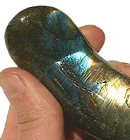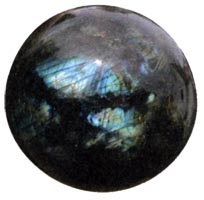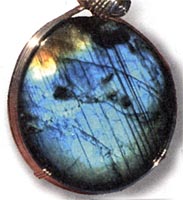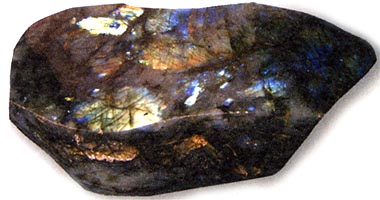LABRADOR

 Characteristics of the mineral.
Characteristics of the mineral.
A special place among feldspars, used as jewelry and ornamental stones, is occupied by a labrador. The mineral is distinguished by a particularly beautiful effect caused by the play of light on the twin blades. Labrador has one-type oriented crystals, from which light is reflected, on one square centimeter there can be several thousand. Mineral from the group of calc-sodium feldspars, plagioclases, isomorphous mixture of sodium feldspar - albite with calcareous feldspar - anorthite, which is contained in labrador in the amount of 50-70%. Chemical composition of CaAl2Si2O8. Color white, gray, brown, blue. Usually the labrador is black or dark shades of gray and brown color, possessing a blue-green game because of the lamellar inclusions of ilmenite, sometimes with pearlescent shine. Shine from glass to metal. Labrador is a part of many basic igneous rocks: gabbro, basalt, diabase, etc. Labrador is included in a series of minerals called "solid solutions." It melts. Hardness 6.
It turns out that solutions do not always look like tea, in which they dissolve a spoonful of sugar. A homogeneous substance, in which two or even more chemical compounds coexist, can also be solid. The most valuable labradors that feature all colors of the spectrum are found in Finland. In Australia, there are transparent labradors that can be cut. The best Indian Labrador in polished condition with its ebb and flow of colors resembles a peacock feather. In Burma, sometimes there is a labrador with iris, as in a moonstone. It is called a black moonstone.
Currently, the Ukrainian labradorite (rock, consisting of 60% of Labradorite) is one of the most popular finishing stones. Breeds, consisting mostly of Labrador, are called labradorites. The best deposits of labradorite are in Ukraine. The stone has an irisation, and it can be attributed to moonstones. The labrador has a bright play of colors - iris in blue, reddish or green tones (labradorization).
Labradorization can be continuous, but more often local, and by the nature of extinction - wavy and mosaic, the geometry of patterns - capricious, patchy, zonal. The colors of the iris are also different - one-, two- and three-color in blue, green, yellow and even red tones. One of the varieties of Labrador is the bull's eye (it has purple-brown, dark red, burgundy-dark brown and red stripes with glare).
Magic properties of stones.
It is believed that Labrador is a stone of Hyperboreans, the most ancient people on the planet. The Labrador is a beautiful wardrobe for the home and all households, it should be kept on the surface so that it can see people, the house and itself was swept up. Wrong advice is to put a stone under the threshold of the house. Talisman practicing mages and all the "wizards" of high level. Labrador hates aspirants for evil, but will not prevent them, however, sooner or later, such people will lead to a very sad end. The stone is very attached to the owner, loves it and seeks to help in all, especially very unpleasant, situations, so the labrador is a wonderful guard for people who have a lot to risk. He is an indispensable talisman of people who seek, but who are firmly on their feet and who always analyze matters, situations that can make at least minimal forecasts. Labrador will connect his master with the past, help to see the connection between the present and past time, draw the right conclusions. The stone will also promote foresight, but only for those who are inclined to this activity by nature, who is given a certain gift and this gift is not spent immorally. Labrador promotes a person who wants to mystically comprehend the world and activities in it.






Poisonous and radioactive dangerous stones and minerals
** - poisonous stones and minerals (mandatory check in the chemical laboratory + explicit indication of toxicity).
** - radioactive stones and minerals (mandatory check on the standard dosimeter + ban on open sales in the case of radioactivity over 24 milli / g / h + additional measures of population protection).
All rare stones are subject to mandatory inspection at the standard dosimeter for the permissible level of radiation and in the chemical laboratory for the absence of poisonous and evaporating components that are dangerous to humans and the environment.


Comments
When commenting on, remember that the content and tone of your message can hurt the feelings of real people, show respect and tolerance to your interlocutors even if you do not share their opinion, your behavior in the conditions of freedom of expression and anonymity provided by the Internet, changes Not only virtual, but also the real world. All comments are hidden from the index, spam is controlled.